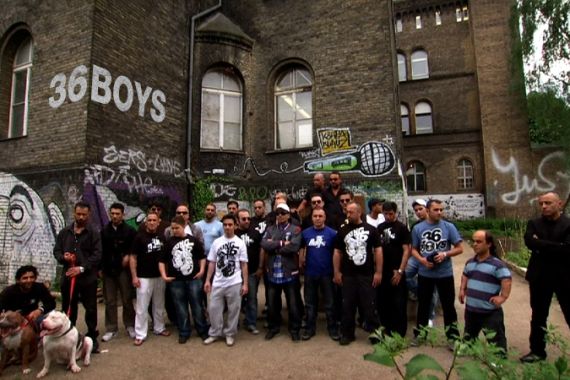
36 Boys
An insight into the struggles of Germany’s Turkish community as revealed through the lives of a Berlin street gang.
Filmmaker: Yelda Kapkin
Today, there are an estimated three million Turks in Germany, the largest ethnic community in the country.
Multiculturalism and the integration of immigrants has been a fiercely controversial topic in Germany.
The 1980s and 1990s witnessed an increase in the amount of racist violence in the country, with racism appearing to increase during the economic crisis throughout the 1980s, and as a result of German reunification in 1989.
Many such attacks were directed at the Turkish community.
“I came to Germany in 1970. Our aim was to earn enough to buy a place back home. But unfortunately we couldn’t achieve that. So we waited for our children to grow up, we waited for our children to finish school,” says Ali Riza Durmus, a former wrestler.
“Then we waited for them to get a job. Then we waited for our grandchildren to grow up. It’s been 42 years of waiting like this.”
By the end of the 1980s in West Germany, the children of Turkish immigrants had begun to form gangs to protect themselves from racist attacks. Such gangs emerged across the country.
The largest gang – in the Kreuzberg district of Berlin – called itself the 36 Boys, named after the old postal code of their area. The gang also included some non-Turks.
The unemployment rate among Turks is double that among native Germans. Studies show that a person with a Turkish name has less chance of getting a job interview than a similarly qualified person with a German name.
Today, former members of the 36 Boys are active within society helping to prevent juvenile delinquency. Now they meet under a new name – 36 Klan.
The 36 Boys represent an important symbol for many young people from ethnic communities seeking to find their way in modern-day Germany.
| Filmmaker’s view |
As the 50th anniversary of Turkish immigration to Germany approached, I wanted to make a documentary about the long years of struggle endured by Turks in the country. It was important to me to tell this story from the perspective of those on the streets, the people who had lived through this hardship.
During my research I came across the names of some Turkish gangs from the 1990s. These were founded to protect Turkish neighbourhoods from attacks by neo-Nazi groups. Most of the gangs had disappeared in the years since – but one remained. 36 Boys from Berlin-Kreuzberg had been one of the largest Turkish street gangs in Germany and had become a symbol of resistance to racism.
As my research evolved, I discovered that many members of the gang had acquired fame and success. Killa Hakan, for example, is a famous rapper whose songs tell the story of street life and who tries to set a good example to young Turks. World boxing champion Muci Tosun, Michelin starred chef Tim Raue and actor Soner Arslan are all former members who have become successful and sought to help other young people from the streets.
I decided to tell the story of Germany’s Turkish community through a film about 36 Boys.
Unfortunately, 36 Boys had not been filmed during its heyday in the 1990s. I had even heard that one camera crew who were permitted to film them then had been treated very badly by gang members. Despite this, I decided to take my chances and to try to convince them to let me into their circle in order to tell their story to the world.
My first meeting was with Killa Hakan. I knew that winning his approval was an important first step as the rest would likely follow the most popular symbol of the gang. We met in front of his house. I suggested that we go to a coffee shop but he wanted to go to a park. As I hesitated for a second over going to the park that had once been the gang’s battlefield, I realised I had no choice but to accept. After a while, I came to understand that it had been a test – they wanted to see how much I would trust them.
Killa was wearing sunglasses, which meant that I could not see his eyes, and behaving very coldly. Along with one of his friends, we went to the park and sat on a bank for a while. I tried to explain why I wanted to tell this story. He listened very carefully and then, without looking at me, said: “You want to be inside? Not just interview with me but to follow my life? There were others who tried that, some ended up badly. How can we trust you? We do not know you. It is not possible. No way.”
I was about to lose all hope, but I kept trying.
After an hour we were playing on a playstation at Killa’s house. He took his sunglasses off and began to talk to me directly, looking into my eyes and making jokes. I was in. And as I suspected, the others followed. I was accepted by all the gang members. It was more than I had dreamed of. But it would not be easy to bring other people onto their territory so I decided to work with the smallest possible crew – just me and my cameraman. Luckily, in a very short period he too was accepted – as the ‘big brother’.
During the following weeks we lived with gang nearly 24/7. For the first time the gang was gathered in front of a camera. They openly and fearlessly talked about the neo-Nazi period, about their fight, how they managed to survive, the situation Turks face in the country today and what they aim to achieve in the future.
Through the story of 36 Boys we followed the struggle of life in Germany for its Turkish residents. We witnessed their efforts to change, to stay clean and become a good example for the youth. During the celebrations of May 1, there were thousands making 36 Boys signs, wearing 36 Boys t-shirts and singing Killa’s songs out loud.
Al Jazeera World can be seen each week at the following times GMT: Tuesday: 2000; Wednesday: 1200; Thursday: 0100; Friday: 0600; Saturday: 2000; Sunday: 1200; Monday: 0100; Tuesday: 0600. Click here for more Al Jazeera World. |
